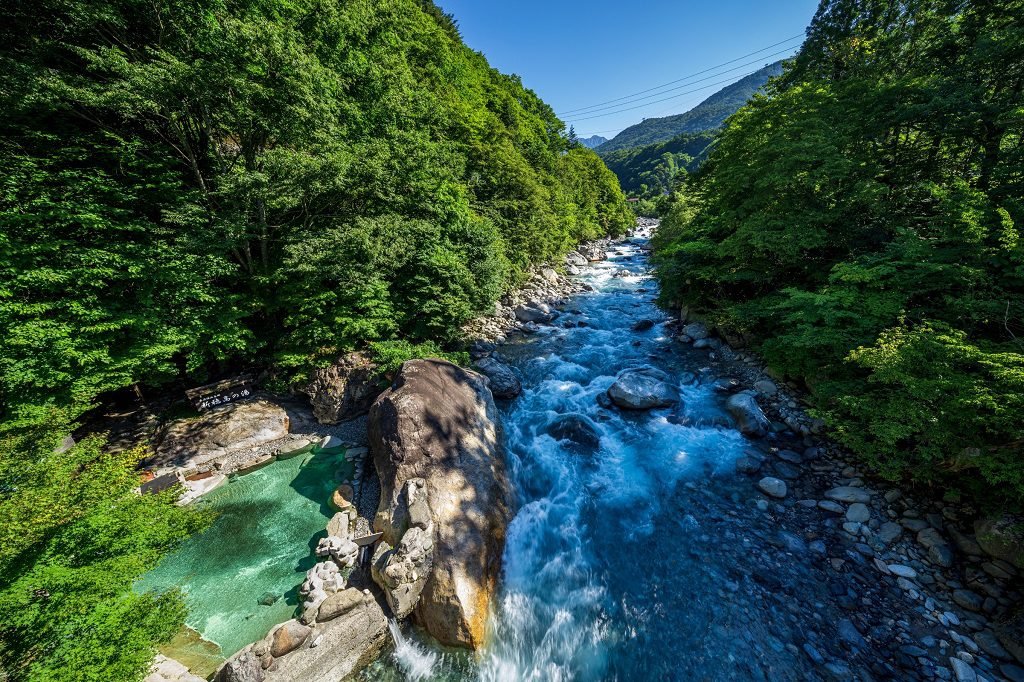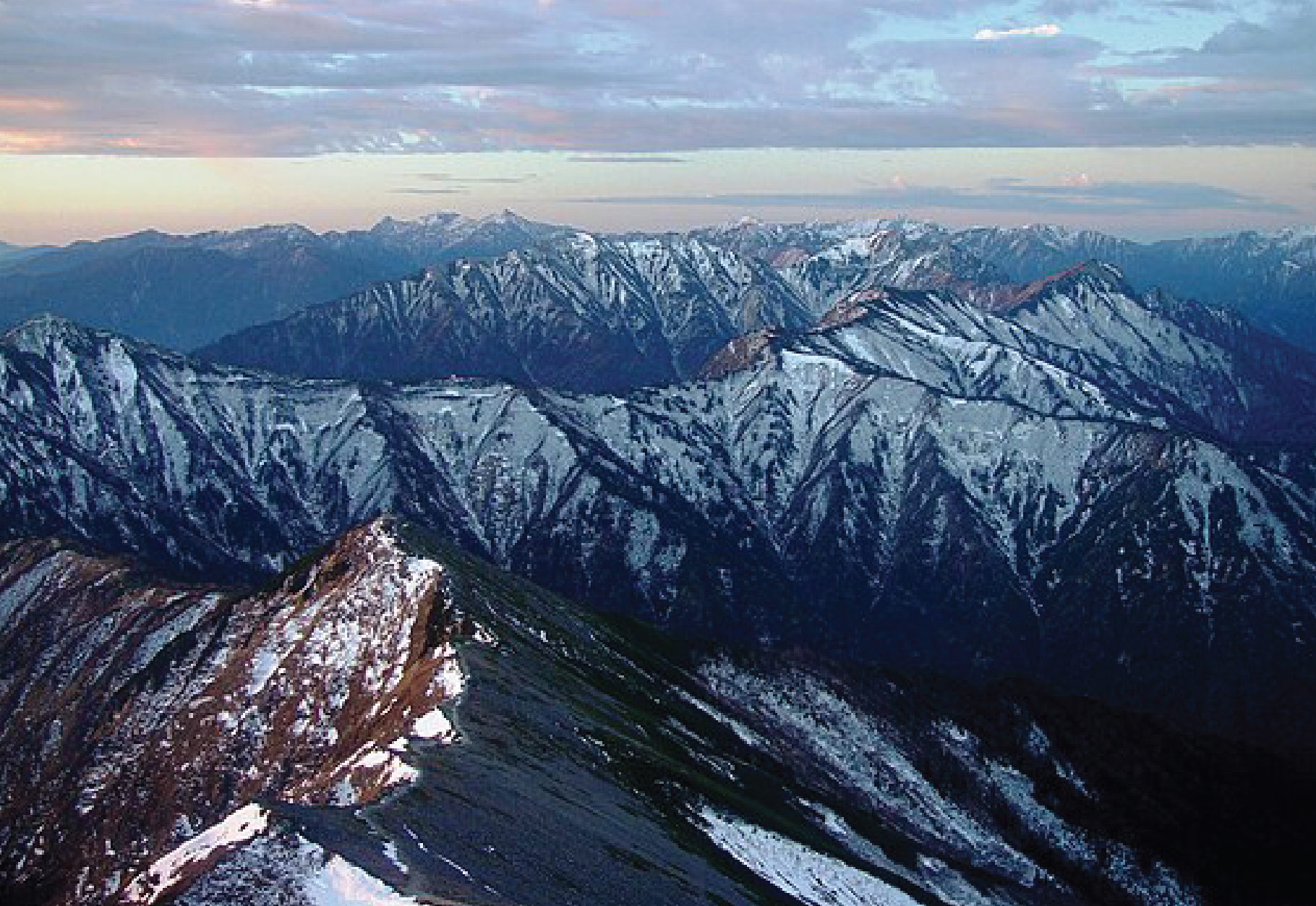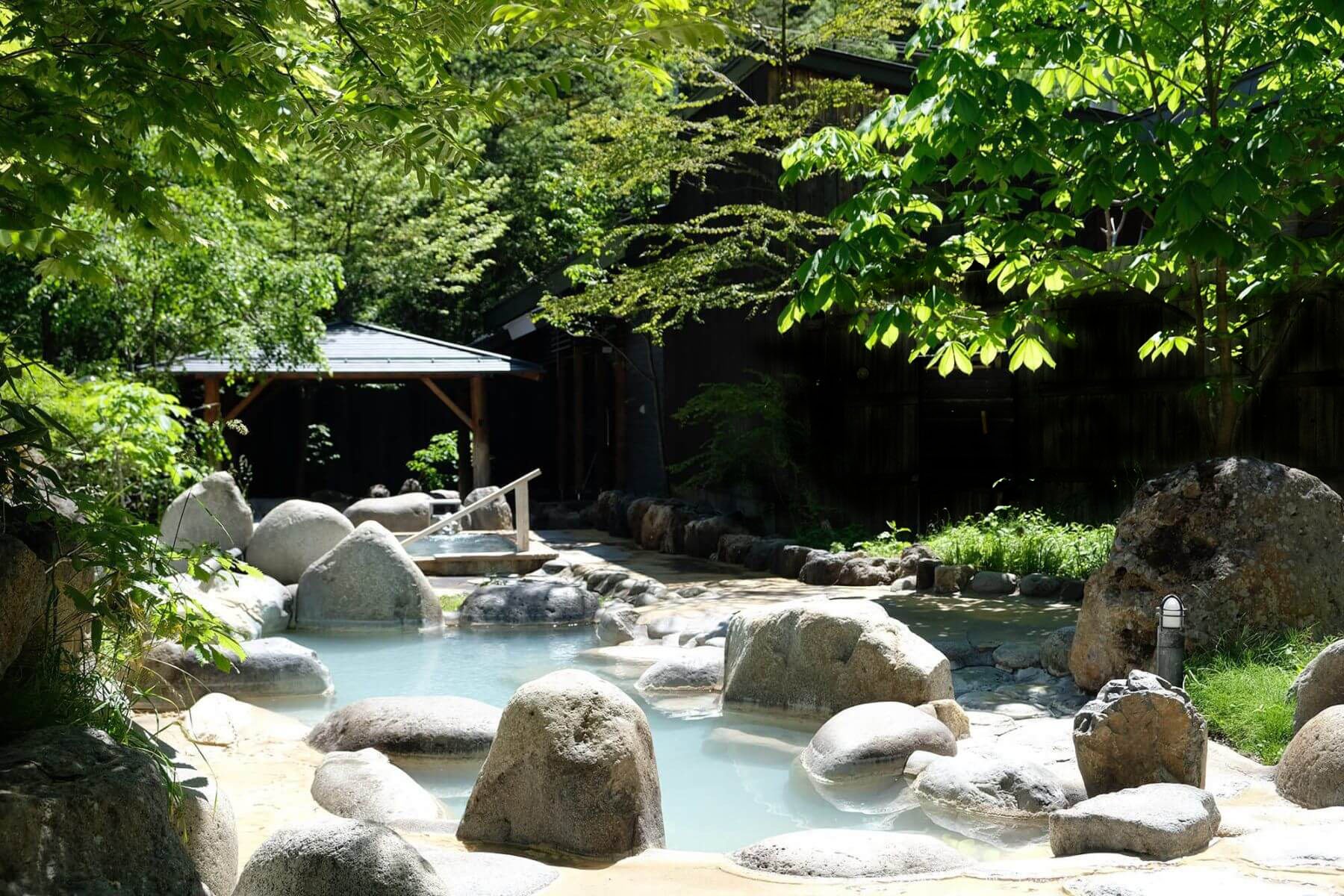Emilie’s Oku Journey
A Slow Loop through the Heart of the Japanese Alps
Kamikochi • Oku-Hida Onsengo • Kamioka • Hida Kawai • Hida Furukawa
Swap neon lights for mountain trails, and city crowds for hot springs under the stars. This route hits popular sightseeing spots, then detours deep into the mountain far off the tourist beat.
We put this route together for our friend Emilie when she visited us in Hida Furukawa in early summer. It’s a a self-guided loop through Japan’s Oku-Hida region of the Hida Mountains, and begins and ends here in Hida Furukawa.
The route follows a quiet arc through Takayama, Hirayu Onsen, the Oku-Hida highlands, and the remote valleys of Kamioka and Kawai. It’s a mix of mountain villages, local buses, forest trails, and open-air baths—ideal for those who prefer quiet landscapes over big-city attractions, and don’t mind the occasional uphill walk.
With basecamps in Hirayu and Kawai (at the community-run NOASOBI Campground), the route offers a good balance of comfort and roughing it - perfect for soaking in onsen or the deep green of the forest.
Overview
Start: Hida-Furukawa
Perfectly formed small castle-town, with wooden shophouses, great carpentry museum, surrounded by rice fields and mountains.
Takayama - The biggest town on the route. Walk the old merchant streets, visit the morning markets, grab hiking supplies and snacks at Muji.
Hirayu Onsen - Soak in open air forest hot springs and top up supplies before heading deeper into the mountains.
Kamikōchi - Choose sedate or dangerous alpine trails to follow through Chubu Sangaku National Park. Slip back in time with grilled fish at Kamonji-goya Hut.
Oku-Hida Onsen Villages - Fukuji, Tochio, and Shin-Hotaka offer timeless ryokan & remote rotemburo.
Kamioka - Explore the mining history in this charming town by riding bikes through old tunnels and forested ravines on old rail lines.
Kawai - Camp, hike, or ski in this lesser-known hamlet with local herb culture and mountain charm.
We offer an interactive version of this Journey Plan to download for free in the Bothie Shop. It’s designed so that you can keep all the info you need in one place on your smart phone. Just bring up the guide on your screen, tap the name of the next destination to see our recommended route on google maps (including our fav coffee stops!).
How to use this field guide
This guide is written for independent travellers who are comfortable heading out of touristy areas into places where nobody will speak English (or accept credit cards). We provide tips to help navigate the things we found confusing or challenging, and context to help English-speaking brains remember Japanese place names.
When to Go
Early summer and Autumn are the perfect time of year for this route. The cool of the Alps also provides relief from the summer heat, and in winter the lack of access to hiking routes is more than made up for by the surrounding ski resorts, and the pure joy of soaking in hot springs surrounded by snow drifts, cedar forests and sparkling icy branches. Maybe stick to the valleys in early spring though, there’s an awkward moment when the snow has melted and the trees are still bare when Hirayu & Oku-Hida are not at their best.
Getting Here & Away
Hida Furukawa is on the JR Hida Express line that links to the bullet train network at Nagoya in the & Toyama, and is about 4.5 hours from Tokyo and Osaka.
Furukawa is a 15 minute train journey from Takayama, which is the closest hub for the highway bus network.
By train or by bus from Osaka, Kyoto it’s best to start this loop in Hida Furukawa or Takayama. If you’re travelling from Tokyo by bus it’s better to travel directly to Hirayu Onsen, and end your loop in Takayama.
If you want to expand your journey in the region, the UNESCO Gassho Hut Village of Shirakawa-go, the castle town of Gujo Hachi-man and Mt Take and Mt Haku are all within striking distance.
Hiking & Camping
Hida locals are mad keen hikers & campers and there are loads of resources available, the official website Chubu Sangaku National Park is very helpful, you’ll find good advice in English in tourist information offices in each town including Hida Furukawa, Hirayu and in Kamikochi itself. We think the best guide book is Walking & Trekking in the Japan Alps and Mount Fuji by Tom Fay & Wes Lang (Cicerone Walking & Trekking Guides), it’s worth buying at home to help plan your trip.
If you’d like us to handle the logistics, get in touch. We can sort camping gear, book a night in a mountain but or a hiking guide - or organise your whole trip.
Roadtrips
This journey is perfect for a roadtrip & and would allow you to explore deep into the mountains. Car camping is pretty wonderful around here because of the lovely campgrounds, Michi-no-eki and natural forest hot springs. It’s the perfect place for campfires and forest bathing.
The national park is closed to private cars though, so you’ll need to park your car in Hirayu and catch the shuttle bus or taxi to the Kamikochi hiking area.
Resources
TBC
Need help with planning?
We offer a custom service that can take care of your bookings, gear rental, luggage forwarding, tours, and even dietary needs like gluten-free, allergy-safe, or vegan options. Email us at for more details, or book a travel consultation.
You can also purchase an interactive journey map from our store, with all the links, routes, and insider tips in one place. All profits stay in Hida and support community programs through Bothie Projects Inc.
Tips for the Journey
Nohi Bus Pass: There are different bus passes that save a bit, some include a ticket for the Shinhotaka Ropeway
Cash Is King: Bring twice as much cash as you think you need. Depending on what card you have you may not be able to use an ATM and most places don’t take credit card.
Pack Smart: Weather changes fast in the mountains - layers help.
Respect Campgrounds: Keep noise down, leave no trace, and follow local rules.
Plan Ahead: Bus times and hut availability can vary. Use the Nohi Bus website for updates.
What is "Oku"?
In Japanese, oku (奥) means "deep," "inner," or "hidden away." It's often used to describe remote, tucked-away places that lie beyond the everyday world - where nature is more untouched, traditions linger longer, and the pace of life slows.
In travel, oku suggests more than just geography. It’s a mindset. To enter the oku is to venture inward - into quiet valleys, mountain paths, or older ways of living.
Oku-Hida literally means "the deep Hida," and true to its name, this region offers a glimpse of rural Japan at its most intimate and unguarded. Here, the landscape opens up to forests, snowfields, onsen villages, and small encounters that often feel like stepping back in time.
Stops & Basecamps
Start: Hida Furukawa (飛騨古川)
Laid-back charm & Hida no Takumi heritage.
A quiet town with white-walled storehouses, Hida Furukawa is all carpentry, canals, and calm. It’s a great place to settle into the slower rhythm of mountain life.
Emilie spent a few days here first, she walked up to the Keta Wakamiya Shrine to say hello to the gods, watched Kimi no Nawa, visited our local waterfalls and prepared for her hike.
About the name: Furukawa (古川) means “old river”—furu (古) is old, and kawa (川) is river.
Think of Furukawa as the “old river town of Hida” with quiet canals, historic warehouses, and old-school charm.
What to Do
Cycle the Canal District: Pedal past kura storehouses, ricepaddies, shrines, and Edo-era streets lined wooden shophouses & koi-filled canals.
Hida Takumi Carpentry Museum : Learn about local carpentry traditions and timber architecture.
Cafe Breaks: Savour a latte and waffle at Kanakoya or gluten-free seasonal curry at Hida Spice Curry Lab.
Stay at Mother’s House: A warm homestay run by locals - the best way to get to know town.
Getting There:
Hida-Furukawa is just 15 minutes by train from Takayama on the JR Takayama Line. The JR Hida Limited Express connects it with Nagoya and Toyama and the wider Shinkansen network, while local Nohi buses serve nearby towns and trailheads.
Stop 1. Takayama (高山)
A lively town with deep traditions and excellent coffee.
A castle town of carpenters and merchants, Takayama blends Edo-period charm with a modern creative streak. It’s the biggest stop on the route and a great place to reset before heading deeper into the mountains.
About the name: Taka (高) means high or tall, yama (山) means mountain. “High mountain” is exactly what it sounds like. The kanji for mountain (山) even looks like a little sketch of a peak—one you’ll start spotting all over Japan.
What to Do
Wander the Old Town: Stroll Takayama’s historic merchant district, where Edo-era buildings house local craft shops, sake breweries, and cafés. Don’t miss the beautiful Sashiko Aikumo shop for hand-stitched textiles and indigo-dyed gifts.
Soak at Takanoyu: A low-key neighborhood sento with a traditional wood-fired sauna—tattoos welcome.
Coffee Breaks: Refuel at local favorites like Tori, Ember, or Falo.
Pick up supplies at Muji: Revel in the fabulous selection of trail snacks and gear available before heading into the mountains.
Getting There:
Train: JR Takayama Line from Hida-Furukawa to Takayama (15 mins), Highway bus from Osaka, Tokyo, Kanazawa and JR Hida Express from Nagoya & Toyama (link to bullet train network)
Stop 2. Hirayu Onsen - Basecamp
Soak under the stars, breathe the alpine air.
Nestled deep in the Japanese Alps, Hirayu Onsen is a hot spring village that’s been welcoming weary travellers since the Edo period. One of five onsen towns in Oku-Hida, it’s a quiet retreat with classic ryokan, steamy outdoor baths, and forest-covered peaks all around. The cool, crisp mountain air is especially refreshing in summer and autumn.
Stay: Hirayu Campground (5–10 mins on foot from the terminal) or a local ryokan for more comfort
What to Do:
Walk to Hirayu Otaki Waterfall
A gentle forest loop (1.5 km one way) leads to this dramatic waterfall, framed by mossy rocks and cedar trees. It’s a peaceful introduction to the region’s natural rhythm.Soak at Hirayu no Mori Onsen
This beloved bathhouse offers indoor and outdoor pools surrounded by trees. Buy a ticket from the vending machine, rent a towel if needed, and let the mineral-rich water do its magic. Local restaurants serve hearty mountain meals like Hida beef curry and soba.Read on for more about:
Day trips or overnight hikes in Kamikochi & Chubu Sangaku National Park
Onsen villages of Oku-Hida
Scenic Shinhotaka Ropeway
Getting There:
Train: JR Takayama Line from Hida-Furukawa to Takayama (20 mins)
Bus: From Takayama Nohi Bus Center to Hirayu Onsen (~60 mins)
Stop 3. Kamioka (神岡)
Old mining town turned adventure hub.
Once a bustling mining center, Kamioka has reinvented itself as a place where physics meets fun. It’s home to Super-Kamiokande, a giant neutrino detector buried in an old mine - and the very fun Gattan Go rail bikes.
About the name: Kami (神) means god or spirit, oka (岡) means hill. Kamioka means “god hill”—and this sleepy town has hidden depths, literally with the observatory lying deep beneath it.
What to Do
Gattan Go Rail Bikes: Ride through tunnels, forests, and over rivers. Helmets provided - book in advance.
Lunch at IRORIS COFFEE STAND: Chill out with hand-drip coffee, sandwiches & homemade sweets.
Climb to Kamioka Castle: An uphill stroll rewards you with views over the town.
Getting There
Bus: Hirayu Onsen → Kamioka (~90 mins, check schedule)
Stop 4. Hida Kawai (河合) - Basecamp
Forest, stars, and river sounds.
The final stop is a peaceful campground near Hida-Hosoe Station in Kawai. Set beside a clear river and shaded by trees, NOASOBI Campfield is an ideal spot to wind down. Facilities include hot showers, cooking areas, and spots for stargazing or hammocks.
About the name: Noasobi (野遊び) means playing in the field—a phrase that captures the joy of life outdoors. It reflects a way of being: gathering, eating, exploring, and living in rhythm with nature. Kawai (河合) combines kawa (河), meaning river, and ai (合), meaning to meet. It refers to a confluence—a place where rivers join. Not to be confused with kawaii (可愛い), meaning cute—though Kawai’s wild paths and mountain herb traditions have a quiet charm of their own.
Getting There
Bus: Kamioka → Hida-Hosoe Station (~45 mins)
From station: Walk (2 hrs) or take a taxi (<15 mins) to NOASOBI
Return Leg: Back to Hida-Furukawa
The loop ends with a scenic ride through rice fields and forested hills, passing landscapes that inspired Kimi no Na wa (Your Name) and its fictional town of Itomori.
Getting There
Option 1: Local Nohi Bus → Hida Furukawa Town Hall (check schedule)
Option 2: JR Takayama Line from Hida-Hosoe Station → Hida-Furukawa Station (20–30 mins)











Kamonji-goya Hut
This rustic mountain hut is more than a rest stop - it’s a living connection to Japan’s mountaineering past. Walter Weston, the British missionary and explorer who helped introduce the Japan Alps to the world, wrote about spending the night here in 1896. He encountered a lone hunter named Kamonji, fishing for trout in the clear mountain streams.
“The only human being in the lonely valley was an old hunter named Kamonji, who, sitting on a rock in the middle of the river, was fishing for trout. He invited us to his hut, which stood just above the bank. We purchased a dozen fish for our supper, and so passed the night as before, stretched upon the floor of the hut, with our boots for pillows and stones for bedfellows.”
Walter Weston, Mountaineering and Exploring in the Japan Alps (1896)
Today, Kamonji’s descendants still run the hut and serve fresh river fish grilled over open coals, just as they did in Weston’s time. It’s a rare chance to taste history and rest where early explorers once did - beside the same river, under the same mountains, and in the care of the same family line.
Oku-Hida Onsen-go
Onsen villages, a castle, an underground lab & mountain switchbacks.
Heading deeper into the mountains, your next leg explores the “Oku” of Oku-Hida - the inner reaches. Stop in sleepy towns like Fukuji and Tochio, known for their rustic baths, snowy winters, and timber buildings.
Getting There
Explore this area on foot, or hop on and off the local bus on the way to Kamioka.
Bus: Hirayu Onsen → Kamioka via Fukuji & Tochio (~90 mins, check schedule).
On and Off the Beaten Path
Even deep in the mountains, a few key spots draw heavy foot traffic—especially during holiday periods like Golden Week, summer, and autumn foliage season. These are major transit points or iconic attractions, and they serve as funnels for visitors heading into the Japan Alps.
Tourist Bottlenecks:
Takayama Station & Nohi Bus Terminal – The main gateway to the mountains. Expect crowds and long lines for trains & buses (we recommend that you skip the Nohi Bus terminal for this trip and catch a local bus to Hirayu from the old town centre).
Hirayu Onsen Bus Terminal – A busy interchange with limited seating and frequent transfer congestion.
Buses to/from Kamikochi, Hirayu, Takayama, and Shin-Hotaka – Popular scenic routes often filled to capacity during peak hours.
Shin-Hotaka Ropeway – A dramatic alpine lift with sweeping views - and large tour crowds to match. Lines and wait times are common.
Where You’ll Find Space to Breathe:
Hida Furukawa – Just 15 minutes from Takayama by train, but a world away in atmosphere. Stroll the canals and explore the backstreets wooden shophouses, temples, and white-walled storehouses without the crowds.
Okuhida Villages (Fukuji, Tochio, Shin-Hirayu) – Known to domestic travelers but often overlooked by international tourists. These rustic onsen towns offer a slower, more traditional rhythm.
Kamioka – Tucked away in the hills, Kamioka is almost entirely off the foreign tourist radar. Once a thriving mining town, today it’s a quiet stop with local museums, riverside walks, and a glimpse into everyday mountain life.
Hida Kawai – A little-known area for slow adventures, skiing, and wild camping. Locals are reimagining the area through projects tied to mountain herbs (yakusō), forest foraging, and nature-based wellness. Drop by NOASOBI campground or chat with its passionate owner about the future of rural living in Japan.
Swimwear is optional at Shinhotaka Outdoor Public Onsen (新穂高の湯). Mixed-gender, and rustic. For more privacy, visit a nearby onsen with gender-separated baths.
Makoto Shinkai’s beloved 2016 film Kimi no Na wa (Your Name) is more than just a romantic fantasy — it’s a love letter to rural Japan. While much of the story takes place in Tokyo, the fictional town of Itomori was heavily inspired by the Hida region, blending real-life locations from Hida-Furukawa, Kamioka, and the surrounding mountains.
The film’s rural setting captures the everyday beauty of mountain village life — wooden homes, quiet shrines, sleepy train stations — with striking realism. If you’re following Emile’s route, you’ll pass several locations that appear nearly frame-for-frame in the film:
Hida-Furukawa Station – where the characters meet on the platform
Hida City Library – a quiet study spot featured in the film
Bus stop near Hida-Hosoe Station – site of an iconic scene in the film
Keta Wakamiya Shrine – inspiration for the film’s mountain shrine, rooted in local Shinto tradition (tip: visit Y*mama cafe before climbing the stairs)

